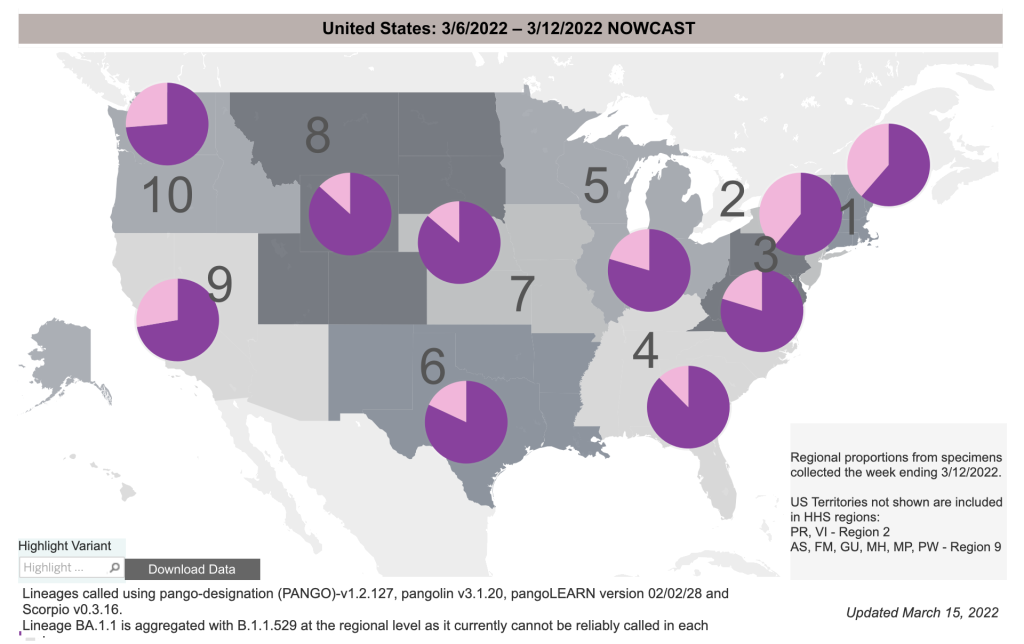“We are seeing an increase in the rate of Bachelor 2 that was revealed,” warned WHO technical leadership on Corona virus disease-19 d. Maria Van Kerkhove. “Of the available sequences, about 75% are BA.2 and 25% are BA.1,” the original Omicron torsion.
Just a month ago, Who is the chest A report on BA.2 showed that the strain represented 21.5% of all new Omicron cases analyzed worldwide in the first week of February. This means that in one month, it has grown more than twice, displacing BA.1 as it did.
“Studies show that BA.2 has a growth advantage over BA.1.” according to WHO analysis, possibly because it settles higher in the respiratory tract, so infection can result from lighter exposure. The WHO report says: “The difference in transmissibility appears to be much smaller than, for example, the difference between BA.1 and Delta,” but it is an advantage.
In the United States, where BA.2 has been nonfunctional until now, variant sequences have doubled every week for the past few weeks, Currently It accounts for 23% of all serial positive tests.
Center for Disease Control
What’s more, the spike in BA.2 cases is occurring across the United States According to CDC data, the variant now accounts for 27% of all sequences in California, Arizona, and Nevada (and it should be noted that California does not differentiate between BA.1 and BA. 2 in publicly accessible case data). In the Southeast, it is only 12%, while in the Northeast it is higher than 38%.
Center for Disease Control
Washington Post Reports That “nearly a dozen countries are experiencing a sharp rise in coronavirus infections caused by BA.2”, specifically in Western Europe, and more specifically in Germany, which has seen highest ever Average number of cases 7 days yesterday. The surge in cases raises concerns about another wave on the American side. Despite an overall steady decline in cases here, US Covid waves often followed those in Europe by 2-3 weeks.
“However, the amount of testing being done around the world is dropping dramatically,” said Dr Van Kerkhove of the World Health Organization. “So our ability to trace this virus, our ability to trace BA.2 is compromised by the reduction in testing, and you can’t sequence those you haven’t tested.”
But Bloomberg Analytics from CDC . Wastewater data It may provide a better view. It found that about 33% of the US sites monitored showed a spike in Covid levels from March 1 to 10. That’s double what it was during the same period in February.
Sewage is often the first—and most accurate—indicator of an upcoming boom because it does not depend on the people deciding to get tested, and it covers the entire population served by each sewage system. A rise in case numbers usually follows a rise in wastewater data after a few weeks.
“While sewage levels are generally very low, we are seeing an increase in the number of sites reporting an increase,” Amy Kirby, who heads the CDC’s Wastewater Monitoring Program, said. He said in the current situation. “These bumps may simply reflect a slight increase from very low to low levels.”
But wastewater in no way provides a complete data set. Many parts of the country are not analyzing wastewater for Covid-19. That could be part of a bigger problem if there really is a wave coming in the US.
“We need a very robust surveillance system around the world for Covid-19,” Dr. Van Kerkhove said this week. “Despite all the challenges we’re facing, we still need to keep testing. We still need to maintain robust sequencing and make sure we have a good geographic representation of the sequences that are being shared so that we can trace this virus in real time.”

“Alcohol geek. Certified web scholar. Travel aficionado. Subtly charming twitter fanatic.”

